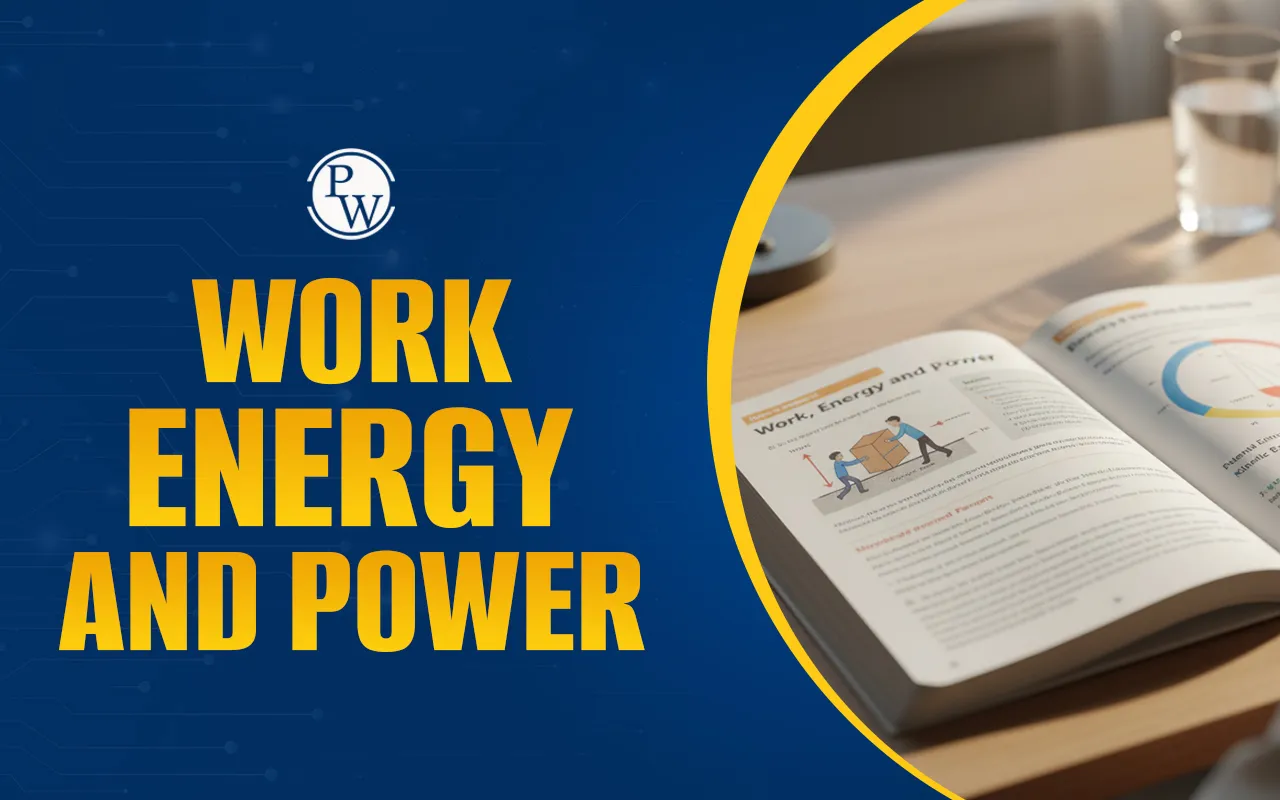

Work, Energy and Power are everyday concepts related to Physics. They help us in understanding the movement of different objects and forces affecting them. Work is done when a force moves an object. Energy is the ability to do work. Power is the rate at which work is done.
The concepts of Work, Energy and Power are used to explain every physical action in the universe. It ranges from the movement of celestial bodies to the simple lifting of a book. Learning about Work, Energy, and Power helps us to understand the science behind everyday actions.
Work, Energy and Power Overview
The terms Work, Energy and Power, as concepts of Physics, have their specific definition. It is important to define these concepts separately. They are as follows:
| Work, Energy and Power Overview | |
| Concepts | Definitions |
| Work |
|
| Energy |
|
| Power |
|
Work, Energy and Power Study Material PDF
Work, Energy and Power are important concepts from which questions are asked in various examinations every year. The questions can be both theoretical and numerical problems. Candidates can download the Work, Energy and Power Study Materials from the table provided below for easy understanding of concepts and practising numerical problems related to it:
| Work, Energy and Power Study Material PDF | |
| Work, Energy and Power Study Material | Download PDF |
Work Energy Theorem
According to the Work Energy Theorem, work done on an object is equal to the change in its energy. For example, if we push a toy car, the work we do increases its kinetic energy.
-
The theorem establishes a direct, mathematical correlation between the net work performed on an object and the resulting change in that object's kinetic energy.
|
Wnet = ΔE k |
-
In simple terms, if positive net work is applied to an object, its velocity increases, and thus its kinetic energy increases. Conversely, if negative net work is applied (e.g., due to friction), the object's kinetic energy decreases, and it slows down.
Conservative and Non-Conservative Forces
Forces are important in Work, Energy and Power. We classify these forces based on how the work they perform relates to the path taken by the object. They can be conservative or non-conservative.
Conservative Forces
-
A force is designated as conservative if the work it performs on an object, moving it between two points, is independent of the path taken. The work depends exclusively on the object's initial and final positions.
-
For example, the Gravitational Force. When an object is lifted, the work done against gravity is the same whether it is lifted straight up or moved up a ramp. It is because the work is fully recoverable. Potential energy is associated with conservative forces.
Non-Conservative Forces
-
A force is classified as non-conservative if the work it performs on an object is highly dependent on the path taken.
-
For example, Friction. If a block is pushed from point A to point B, more work against friction is performed if the path is long and winding than if the path is short and straight.
-
The work performed against friction is typically converted into thermal energy (heat) and sound, which dissipates and cannot be fully recovered to perform useful work.
Elastic Potential Energy
-
Elastic Potential Energy is stored energy in stretched or compressed objects. The formula for elastic potential energy:
|
E = 1/2 k x² |
-
Potential energy represents stored energy. While gravitational potential energy relates to an object’s height, Elastic Potential Energy relates to an object's configuration or shape, specifically its ability to be deformed and then return to its original state.
Conservation of Mechanical Energy
The Conservation of Mechanical Energy is one of the most fundamental laws in Physics. It states that energy cannot be created or destroyed. It only changes from one type to another.
-
This principle is useful in understanding Work, Energy and Power because it shows that energy is always conserved in a system without friction.
-
The law states that if only conservative forces (like gravity) are acting within a system, the total mechanical energy of that system remains constant, or conserved.
Elastic Collisions
A collision refers to a small and strong interaction between two objects. It is classified based on the conservation of kinetic energy.
-
An elastic collision is an ideal concept where the total kinetic energy of the system is conserved before and after the collision. The momentum of the system is also conserved.
-
In a perfectly elastic collision, no energy is converted into non-mechanical forms like heat, sound, or permanent deformation of the colliding objects.
-
In the real world, most of the macroscopic collisions are inelastic because some kinetic energy is lost to either heat, sound, or some form of deformation.
-
Understanding the theory of elastic collisions allows physicists to understand the maximum possible energy transfer and the conservation laws that govern the interaction of Work, Energy and Power.
Instantaneous Power
Power is defined as the rate of doing work. Average power is calculated in dynamics; however, it is necessary to know the power at a particular moment. Instantaneous Power is the power delivered or absorbed at a single, specific instant in time. The concept is highly relevant to machines that operate with varying speed and force.
The Average Power is calculated over a measurable interval of time.
|
Average Power = Work Done/Time Taken |
